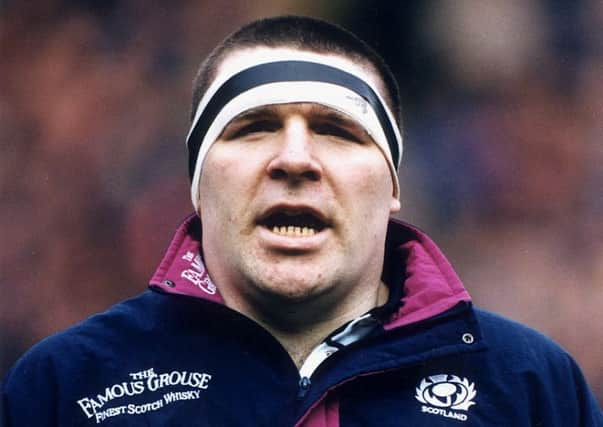Richard Moore: Some sports are becoming preserve of freaks


Now he watched as Alex Dunbar limped off and match commentator Bill Johnstone observed, not for the first time, that it had been an “attritional” game – attritional, like “bruising,” being a euphemism for the spectacle of enormous bodies crashing into one another, leaving them strewn across the pitch.
“You know what, Bill,” began Wright. “I know this is maybe quite controversial but I just wonder how long rugby can go as it’s currently going. The guys are still getting bigger. It’s not as if they’re getting smaller. The backs are getting bigger, the forwards are getting bigger, you’re getting 20-stone and 21-stone players, and there’s still no protection.”
Advertisement
Hide AdAdvertisement
Hide AdPerhaps Wright’s eye had been caught by Uini Atonio, the 24-stone (155kg) French prop. Wright, a former prop himself, was hardly diminutive (though in his prime he’d have been conceding more than six stone to Atonio). He continued: “You just wonder where it’s going, that’s my concern. One of the medics, one of the distinguished rugby medics, even said that at some point there’s going to be a fatality in rugby, which is a horrific thing to think about. But when you see the size of these guys and how hard they hit each other, it’s…”


Play resumed, Wright was interrupted, but his words were ominous and they hung over the rest of the game.
If one concern is health and safety, another is the effect on the game, or the spectacle. The transformation has been dramatic. The TV coverage of almost every Six Nations game is preceded by footage from a historic fixture. Historic in this context might mean 1995, yet it looks like a different sport. The slim and athletic players of yesteryear wouldn’t last ten minutes in the current game. Imagine Atonio smashing into willowy (by comparison) Gregor Townsend.
You don’t need scales to measure the difference – only eyes. But the stats bear it out: a BBC study found that the average weight of British players had gone from 85.7kg in 1962 to 104kg in 2012, though the biggest change has been since 1995, when the game went professional. In 2012, the English forwards were an average of 112.9kg; four years later it was 114kg. The trend is, as Wright noted, going only in one direction.
For many, bigger is not better. Like a sumo wrestler landing on a jockey, the increasing emphasis on weight surely acts to pulverise skill and flatten technique. You would imagine, then, that the game would be less entertaining. And yet, paradoxically, the opening two weeks of the Six Nations have produced games hailed as classics.


The elephant in the room is not the elephantine prop, but the suspicion that doping could offer one explanation for the proliferation of huge, muscular and athletic players. In the NFL, players bulked up dramatically in the late 1960s and early ’70s, when steroid abuse was rampant (NFL defensive tackles went from an average 106kg to 127kg between the 1940s and 1990s).
However it is achieved – and many of rugby’s doping cases do seem to involve players who are simply not big enough trying to bulk up – what of Wright’s concern that there will be a serious injury? In New Zealand there are weight as well as age categories, and not just in the younger age groups: some clubs offer under-80kg rugby for adults. But at the professional level weight limits are not feasible. The trend of ever larger players seems irreversible.
It is also fits with a wider trend in sport, highlighted by David Epstein in his 2013 book, The Sports Gene. Epstein talks about “the Big Bang of body types”, identified in a 1990s study in Australia which tracked changes in body types in various sports since 1925, when most clustered around the average physique; when you could attend the opening ceremony of an Olympic Games and not be sure who did which sport. Since then, writes Epstein, “Just as the galaxies are hurtling apart, so are the body types required for success in a given sport speeding away from one another toward their respective highly specialised and lonely corners of the athletic physique universe.”
Advertisement
Hide AdAdvertisement
Hide AdNo insult is intended by saying that some sports are increasingly the preserve of freaks. Football is the one where you might have the greatest chance of making it with a “normal” body – but still, only 28 per cent fit into the bivariate overlap zone (BOZ): the probability that a person randomly selected has a physique compatible with a given sport at the highest level. The figure is only 9.5 per cent with rugby forwards. And in some sports it is even more extreme: an American male of 6ft 2ins to 6ft 4ins has a 20-in-a-million chance of playing in the NBA; if he is seven foot, he has a one-in-six chance.
The Big Bang of body types means that other sports could become more prescriptive and more exclusive. As Wright said of rugby, “the guys are still getting bigger”. Thus, the number of people who can even think about playing international rugby will shrink, just like the bodies of elite female gymnasts (who have gone from an average 5ft 3ins in the 1980s to 4ft 9ins now). The “big bang” that Wright worries about might have a particular meaning in rugby, but in sport more generally it means that while more people watch professional sport, fewer and fewer will be equipped to take part.